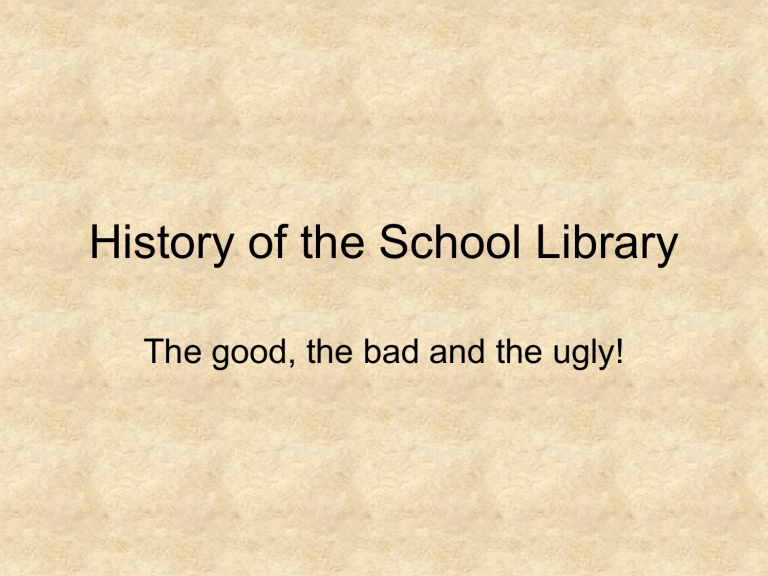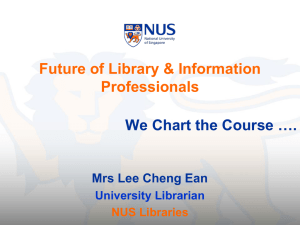Chapter 1--Historical Perspective of the School Library

History of the School Library
The good, the bad and the ugly!
Early Beginnings
• 1835, New York state leads the way allowing school districts to use tax monies to establish and maintain school libraries.
• Several other states followed
• Basically failed start because:
• Contained mainly textbooks or teacher materials
• Market flooded with poor quality texts
• Poor on no facilities to house
• Rise of the public libraries competed for monies
2
Dewey love Dewey or What?
*1876 Date of Modern Library Movement**
• Melvil Dewey helped create the American
Library Association (ALA)
• First issue of Library Journal (Dewey helped create)
• Dewey helped draft a bill that passed the legislature in 1892 providing for matching funds for school districts for purchasing library books.
– Only books on approved lists
– Collections to remain in the school at all times
• Occasionally lent out materials for two week periods
– Classroom teacher serve as librarian
3
More
• The Library Section of the National
Education Association is created in 1896 after Dewey gives an impassioned speech on the importance of libraries in education to the their convention.
4
Standards
• New York, 1892, School Library Division of
Department of Public Instruction formed which issued a report in 1900 that stated the first standards for libraries in elementary schools :
– “…suppose it to consist of five hundred to one thousand books, containing the best classic stories, poems…the best books of this character should be found in every grammar school.”
5
Good Beginnings?
• 1914, Many developments show gradual and encouraging growth:
– New York recognizes librarians as teachers rather than clerks.
• Salaries comparable to teachers and recommended librarians be graduates of approved library school.
• In truth school libraries lagged behind development in other library areas.
6
Competing forms of school library service during this time
1.
Rural areas relied on traveling or “package” libraries to schools
2. Urban areas used the public library resources
3. Branches of public libraries created in the schools themselves to supply services to children and adults
4. Branches of public libraries in schools exclusively for students and teachers but administered by the public libraries.
7
Outside Forms of Library Service
• The result was that the library was never an integral part of the school program but was considered an outside agency
• Still, many of these forms persisted until the mid 50’s
• The pattern that finally emerged was an independent library in individual schools under the control of an education board.
8
Further Developments post WWI
• Rapid growth in education and libraries due to:
1. General population increase
• 50% rise in school population between 1900-
1930
2. Faith in the importance of general education
3. Less child labor
4. School attendance regulations
5. Centralization of schools
• More money to afford libraries and librarians
9
Further Developments post WWI
• Teaching methods undergoing many changes:
– Stress on individualized instruction
– Recognition of differences among children
– New curriculum structures based on John
Dewey (no relation to our beloved Melvil!) stressed the need for a variety of educational materials.
10
Other Developments
• Charles Certain chaired an NEA committee on the status of the school library.
• The “Certain Report” was published by ALA in
1920 and painted a dismal picture of the school library.
• The recommendations of the report such as:
• Physical size
• Librarian qualifications
• Collection size
• Media center concept
– Were extremely important as they provided a yardstick to evaluate libraries and became the framework from which other accrediting agencies developed standards.
11
1960’s – Great Period of Library
Growth
• Standards for School Library Programs
(AASL)
• Department of Audiovisual Instruction
(DAVI) later became the AECT
(Association of Educational
Communications and Technology)
– Recommendation that library and audiovisual collections be combined
12
Federal Monies
• Passage of the Elementary and
Secondary Education Act in 1965 had tremendous impact.
– Title II of this act provided millions for school libraries and created tremendous growth in school libraries.
13
Model Libraries
• Knapp School Library Project funded the establishment of several ideal school libraries across the country from 1963-
1968.
– Thousands of educators visited these demonstration centers or learned about them through the written word and thus had a conception of what was possible.
– Hundreds of new libraries founded.
14
Emergence of the School Media
Center mid 60’s
• New emphasis on basic principles of student learning led educators to try new strategies and break with traditional methods:
– Children learn as individuals
– Children learn at various rates
– Children learn according to different styles and patterns
– Education is a continuous process
• Resulted in the adoption of a unified media program administered through a school library media center.
15
1970’s
• In Media Programs: District and School by
AASL and AECT
– Greater emphasis is placed on executing the instructional program rather than just support
– Recommended at least 10% of the average per pupil cost expended by local boards be used solely for materials and equipment within the district.
16
Declining Financial Support, 1980’s
• Cutbacks in government spending delayed implementation of recommendations by the White House Conference on Library and Information Services to guarantee adequate media services in each public school.
– Declining enrollments
– School closings
– Elimination of staff
17
Growing National Conservative
Outlook, 1980’s
• More censorship cases
• Landmark Supreme Court Decision involving book banning handed down in
June 1982: Island Trees vs. Pico.
– Lawsuit brought by 5 students led by Steven
Pico against Island Trees school district for the school board’s removal of nine books from the high school library.
• Books met valid selection criteria
• Appeared on conservative list of objectionable titles
18
Island Trees vs. Pico
• In a 4 to 5 decision the Court limited the power of public school officials to remove books simply because they found them objectionable by ruling that the school boards must defend their motives in court.
• Led to strengthened resolve by ALA/AASL to fight for intellectual freedom.
19
1988 Information Power
• AECT and AASL jointly released
– Information Power: Guidelines for School
Library Programs
• Guidelines to foster quality school media programs
• Promoted the school library media specialist as a proactive initiator and partner with other educators as an instructional team.
• Defined three roles of the school media specialist
– Teacher
– Information specialist
– Instructional consultant
20
1990’s, Political Activism
• National Library Legislative Days
– Librarians all over the country meet to support legislation for library funding.
– Some of the most important legislation to come out of this effort involves technology
• Copyright and Distance Education Laws
• Opposition to filtering requirements
• Telecommunications Act of 1996 to provide discounted telecommunications e-rate for libraries
21
Internet Problems
• ALA opposed the Children’s Internet
Protection Act since it required schools and libraries receiving federal funds to use technology to block or filter material harmful or inappropriate for children but it was upheld by the Supreme Court in 2003.
22
Library Power Project
• DeWitt Wallace-Reader’s Digest fund to improve elementary school libraries.
(private funding)
– $45 million for 10 year period to nineteen communities in the USA to improve teaching and learning through school library media centers.
• Schools agreed to:
– Employ full-time media specialist
– Provide matching funds
– Flexible scheduling
– Emphases on the instructional role
23
1990’s Rapid Technological Growth
• Early 90’s, few school media centers automated
• In ten years the majority of school library media centers had automated and Internet access was commonplace.
24
Technology = Big Change
• Computers and Internet access
– Changed the way students and faculty would do research forever
– Changed the way librarians worked with students and faculty since information could be found so quickly
– Schools moving toward an Internet-enhanced curriculum
25
Changes in the Role of the Library
Media Specialist
• Site based management where decisions made at the local level required librarians to become leaders and proactive members of the decision making team with teachers and administrators.
• Become information literacy advocates and instructional collaborators.
26
Information Power, 1998
• New standards reflected the expanded role of the school library media specialist.
– Instructional partners
– Program administrator
– Informational specialist
– Teacher
27
Information Literacy
• Information Power, 1998, placed
Information Literacy standards at the center of the focus in the guidelines.
• The proliferation of information throughout our society means students must have information literacy skills to live and function successfully in society in the future.
28
Future
• Shortage of Library Media Personnel
• Libraries becoming more virtual reality entities – access from other than location
• Research showing connections between student achievement and good school media centers
• More attention
29
The End
30





